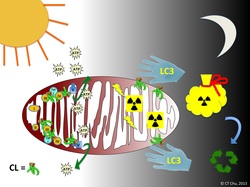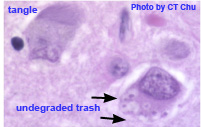| So you are doing everything "right" – sorting your landfill trash from recyclables, composting and switching to biodegradable plastic! Yet the question remains as to how long your trash may stay around. Click the button below to link to an experiment by Science Buddies that you can use to test which product really is best. How big a trash heap will build up if you add a new lunch container every day before the first one disappears? | Brain cells can live more than 100 years without being "reborn" through cell division. Thus, they have to be efficient in recycling their trash. Two weeks ago, we discussed how the brain cell knows when it needs to to "eat" damaged power plants (mitochondria) before they can leak harmful substances. http://dx.doi.org/10.1038/ncb2837 In Alzheimer's disease, even after the cellular trash has been picked up by autophagosomes (recycling trucks of the cell), something goes wrong and the trash is not broken down in the lysosome. Lysosomes are cellular bags that contain digestive enzymes to break down cellular trash, just as the microorganisms break down biodegradable waste in the Science Buddies Experiment. For a lot more details, click above for a review by a top Alzheimer's researcher http://dx.doi.org/10.1038/nm.3232 |
How long does your trash hang around? From "biodegradable" plastics to Alzheimer's disease10/22/2013
0 Comments
 Molecules that have a regular “day job” in the normal function of the cell must also be ready to act differently in case of an emergency. The mitochondrion (the football-shaped structure in the middle) is the power plant of the cell. Cardiolipin (CL) is a special type of fat that normally functions as part of a team of molecules on the inner mitochondrial membrane to generate a type of energy called ATP. This process is important, but also dangerous (think of a car that uses gasoline—the gasoline can be very useful to power the car, but if it leaks out of the tank it could be a problem). If the mitochondrion is damaged, risking the leakage of harmful molecules, CL travels to the outer surface of the mitochondrion to send “help me” signals that are recognized by a protein called LC3. LC3 packages broken pieces of the damaged power plant into autophagosomes (yellow bag) so that its components can be recycled. This process is called "autophagy" - which means "self-eating." doi:10.1038/ncb2837. |
AuthorScientist, Mother, Physician, Educator. My first paper was on neural programs that control fish feeding, later wandering through macrophage antigen "nibbling", to my current interests in brain autophagy (cellular eating of damaged or unneeded parts). ArchivesCategories
All
|


 RSS Feed
RSS Feed
